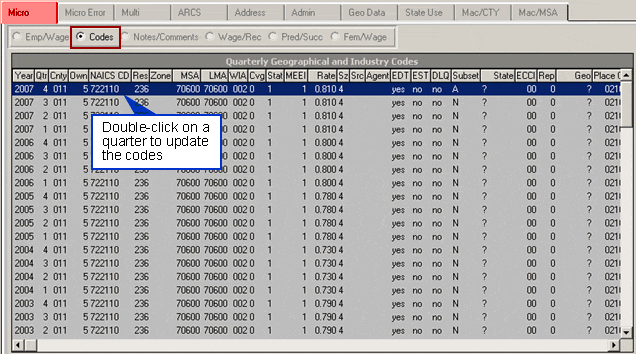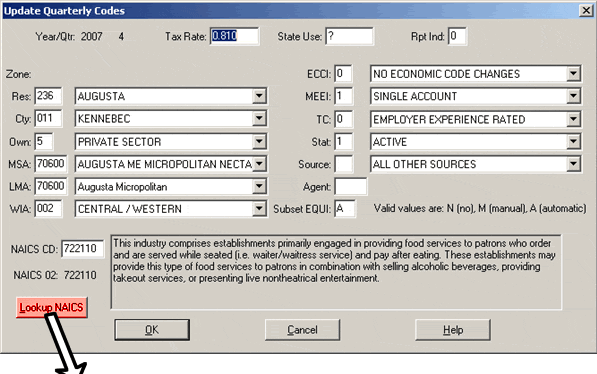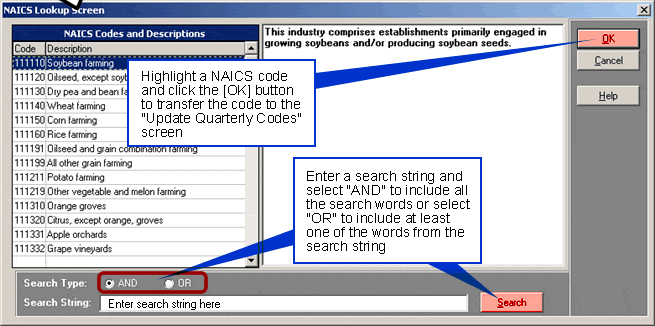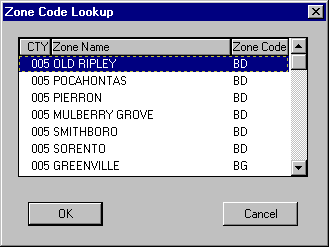Home → Contents → Chapter 3 → Page 1 / 2 / 3 / 4 / 5 / 6 / 7 / 8 / 9 / 10 / 11 / 12 / 13 / 14 / 15 / 16
Codes Radio Button
The Codes tab displays quarterly code information. Use the vertical scroll bar to view more quarters and/or the horizontal scroll bar to view more codes.

The following codes are listed on the codes tab. A more detailed description of each indicator code can be found on the Look-Up Tables. See Chapter 5 Lookup Tables for more information.
- Agent Code—A 4 digit alphanumeric field used to identify companies, such as payroll providing firms and tax filing firms, who file UI reports or MWR reports for other establishments.
- Auxiliary Code—Indicates the type of service the unit provides for other establishments of the same enterprise. If the unit does not provide an auxiliary service for another part of the company, a "5" (designating operating establishment) is coded in this field.
- Class Code (formerly City ID)—Identifier that explains the Place code field. If no place code is assigned, then no class code will be assigned either.
- Census ID—Census block based on the physical location address. BLS uses the automatic assignment of Census block found in the GeoStan software.
- Census Track—BLS-supplied from GeoStan software. Census tract based on the combination of latitude and longitude information mapped to Census-supplied boundary tables. A small, relatively permanent statistical subdivision of a county delineated by a local committee of census data users for the purpose of presenting data. Typically corresponds to the physical location of an establishment and is only included for units with physical location addresses.
- County—FIPs county code based on the unit’s location or place of business.
- Coverage—Each employer covered under the State’s Unemployment Insurance or Unemployment Compensation for Federal Employees is assigned a type of coverage using a State-specific coding scheme. These codes identify whether the employer is determined to be experience rated, covered under a standard contributions rate, or is an employer who is not required to pay contributions but must reimburse taxes when a claim is filed against the account. Three States have a provision for the possible use of employee contributions. Several States also collect data from non-UI/UCFE covered employers.
- ECCI (Economic Code Change Indicator)—Code assigned to a micro level data record to indicate an economic change in NAICS, county or township area, or Ownership codes.
- Geo (Geocode Source)—Indicates where the latitude and longitude were originally assigned. Potential sources include: State 202 unit, BLS-Washington, or outside vendors. A default of blank is used when no latitude and longitude are assigned.
- MEEI (Multi Employment Establishment Indicator)—This indicates if the account is a single, master or subunit.
- NAICS (North American Industry Classification System)—codes are uniform industrial codes used by the United States, Canada, and Mexico to identify the primary activity of an establishment. The NAICS code uses the NAICS Manual definitions for the handling of auxiliary establishments, in which each establishment is classified based on its own activities.
- Ownership—A one-position field showing the legal proprietorship of the enterprise and describing the economic ownership of the enterprise (e.g. private, state, federal, or locally owned entity).
- Place Code (formerly City Code)—Five digit code assigned on Census supplied boundary tables and latitude and longitude. Note: Not all records that are assigned latitude and longitude values will also be assigned place codes. Place codes will only be assigned for selected class codes, as defined in the NIST web site at http://www.itl.nist.gov/.
- Rate—Tax rate used during the reference quarter to tax contributory employer's taxable wages to meet the employer's obligation to the UI fund. Tax rates should be assigned, typically by the UI tax unit, to all active, tax-rated or experience-rated accounts.
- Reporting Change Indicator—Indicator to show whether an apparent change in reporting from multi-establishment employer to single establishment employer, or from single to multi, is a reporting change and not an actual economic event such as a birth, death, acquisition, or sale of a worksite. The field is an optional use field, manually assigned in the State, in the quarter when the change occurs.
- SIC (Standard Industrial Classifications)—Identifier of the primary economic activity of the reporting unit. The primary activity is the primary product or group of products produced or distributed (or services rendered) by the establishment (reporting unit). The primary activity of the enterprise is the primary activity of the establishments within a State.
- Source Code—A 1 digit alphanumeric field used to identify multi-unit UI accounts whose MWR data are provided by the EDI Center; are not provided directly to the State by employers (or their agents). Valid values include: E,C,Q,S,X and blank (default value all other sources). If the current quarter source code is "S" or "Q" the new quarter is assigned a blank. If the current quarter source code is "E" the new quarter is assigned an "E". If the current quarter source code is "C" the new quarter is assigned an "E".
- Specifying a Residence Code (New England states) automatically fills in associated County, MSA (Metropolitan Statistical Area), LMA (Labor Market Area) and WIA (Workforce Investment Act/Area) Codes. Specifying a county code (other states) automatically fills in associated MSA, LMA and WIA codes. To change a code double-click one and type a new one or use the drop down list to select one. Press [Enter] to fill in its' associated description or choose from a list on the drop down box.
- Status—Indicates whether or not the record is active for ES-202 purposes. This does not refer to the UI status of the record. If a record is active for any part of the quarter, it is active for the entire quarter.
- Subset EQUI—Indicator used to mark an account to be included for the Subset EQUI. Accounts can be set via the new Subset Data Entry Screen or through the Codes Update Screen.
- Zone—has been added to the screen to accommodate those states who use zones which are coded alphanumerically. This field is distinguished from the numeric residence code other states use. Also, the residence code continues to be included on the EQUI however, the "zone" code will not.
Changing Information on the Codes Screen
The following fields can be updated via the codes screen: Tax Rate, Geo Code, Report Indicator, Zone, Residency (res/town), County, Ownership, Auxiliary, Economic Code Change Indicator (ECCI), Multi Employment Establishment Indicator (MEEI), Subset EQUI Indicator, Experience Rating (TC), Status, Source Code, Agent Code, NAICS, and SIC codes
To Update Codes:
- Double-click on a year and quarter you wish to change in the browser. The "Update Quarterly Codes" screen will appear.
- Update the desired information. Note: If the quarter has been locked, you must have EQUI (produce deliverable/truncate log file) and update permissions to update. If the quarter is closed and not locked you only need update permissions.
- Use the [Lookup NAICS] button to display the "NAICS Lookup Screen" to search for codes.
- Click [OK] to save changes. If you do not wish to save changes, click [Cancel].


Zone Lookup
Also available to the user on the "Update Quarterly Codes" screen is the zone code lookup. Note: This function can be used provided the use of zone codes are enabled from the Administrative Functions/State Info tab.
To Lookup Zone Codes:
- Place your cursor in the zone field by clicking on it or tabbing to it and press the [Enter] key. The Zone code Lookup screen displays only zone codes for the selected county code.
- Highlight a zone.
- Click on [OK] to fill the zone field.

